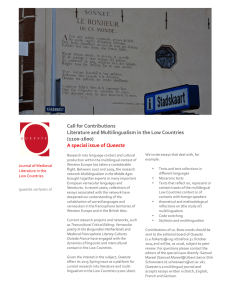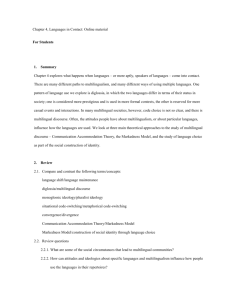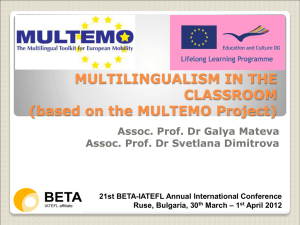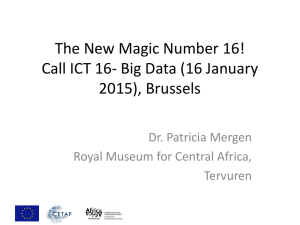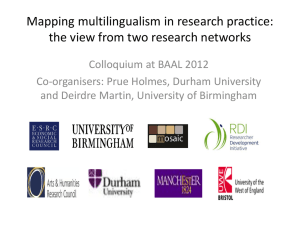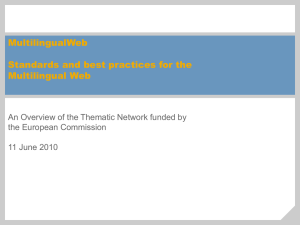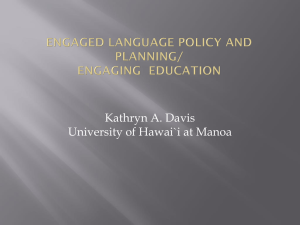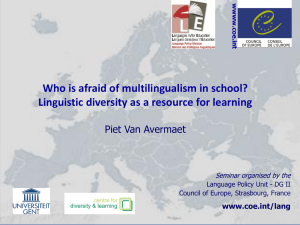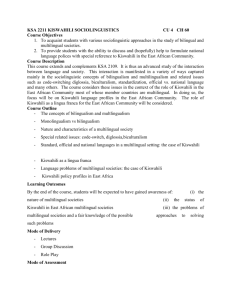Multilingualism and Plurilingualism
advertisement
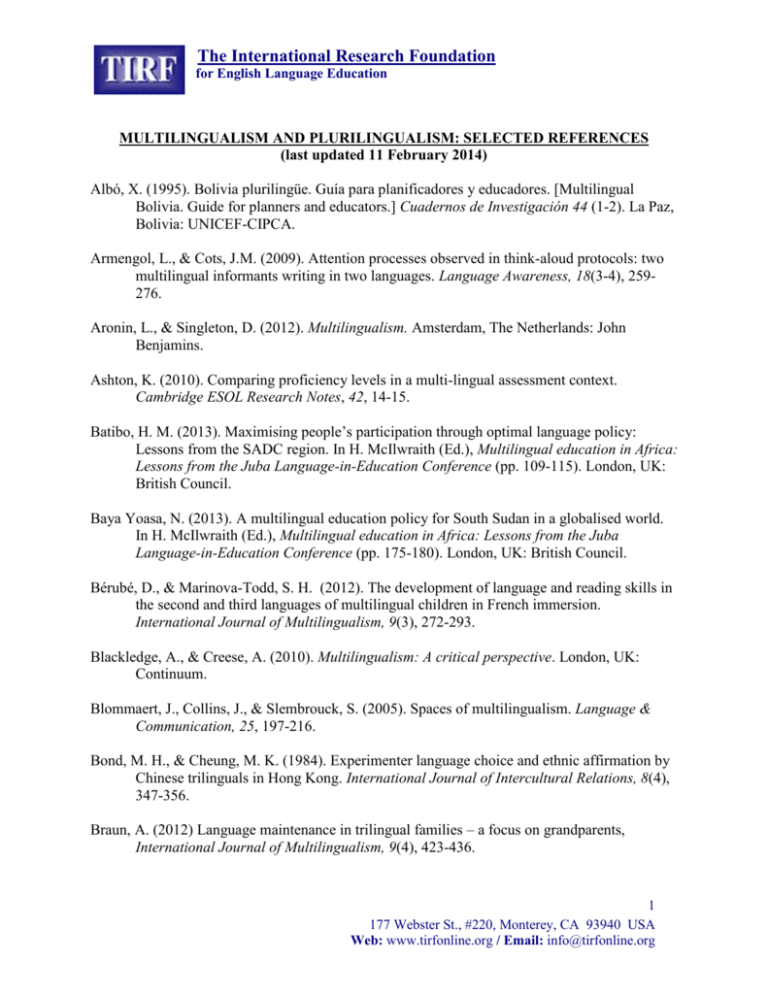
The International Research Foundation for English Language Education MULTILINGUALISM AND PLURILINGUALISM: SELECTED REFERENCES (last updated 11 February 2014) Albó, X. (1995). Bolivia plurilingüe. Guía para planificadores y educadores. [Multilingual Bolivia. Guide for planners and educators.] Cuadernos de Investigación 44 (1-2). La Paz, Bolivia: UNICEF-CIPCA. Armengol, L., & Cots, J.M. (2009). Attention processes observed in think-aloud protocols: two multilingual informants writing in two languages. Language Awareness, 18(3-4), 259276. Aronin, L., & Singleton, D. (2012). Multilingualism. Amsterdam, The Netherlands: John Benjamins. Ashton, K. (2010). Comparing proficiency levels in a multi-lingual assessment context. Cambridge ESOL Research Notes, 42, 14-15. Batibo, H. M. (2013). Maximising people’s participation through optimal language policy: Lessons from the SADC region. In H. McIlwraith (Ed.), Multilingual education in Africa: Lessons from the Juba Language-in-Education Conference (pp. 109-115). London, UK: British Council. Baya Yoasa, N. (2013). A multilingual education policy for South Sudan in a globalised world. In H. McIlwraith (Ed.), Multilingual education in Africa: Lessons from the Juba Language-in-Education Conference (pp. 175-180). London, UK: British Council. Bérubé, D., & Marinova-Todd, S. H. (2012). The development of language and reading skills in the second and third languages of multilingual children in French immersion. International Journal of Multilingualism, 9(3), 272-293. Blackledge, A., & Creese, A. (2010). Multilingualism: A critical perspective. London, UK: Continuum. Blommaert, J., Collins, J., & Slembrouck, S. (2005). Spaces of multilingualism. Language & Communication, 25, 197-216. Bond, M. H., & Cheung, M. K. (1984). Experimenter language choice and ethnic affirmation by Chinese trilinguals in Hong Kong. International Journal of Intercultural Relations, 8(4), 347-356. Braun, A. (2012) Language maintenance in trilingual families – a focus on grandparents, International Journal of Multilingualism, 9(4), 423-436. 1 177 Webster St., #220, Monterey, CA 93940 USA Web: www.tirfonline.org / Email: info@tirfonline.org The International Research Foundation for English Language Education Braunmuller, K., & Gabriel, C. (Eds.). (2012). Multilingual individuals and multilingual societies. Amsterdam, The Netherlands: John Benjamins. Brown, K. D. (2013). Language policy and education: Space and place in multilingual postSoviet states. Annual Review of Applied Linguistics, 33, 238-257. Cabrelli Amaro, J., Flynn, S., & Rothman, J. (Eds.). (2012). Third language acquisition in adulthood. Amsterdam, The Netherlands: John Benjamins. Canagarajah, A. S. (2006). Toward a writing pedagogy of shuttling between languages: Learning from multilingual writers. College English, 68(6), 589-604. Canagarajah, S. (2007). Lingua Franca English, multilingual communities, and language acquisition. Modern Language Journal, 91, 923-939. Canagarajah, S., & Ashraf, H. (2013). Multilingualism and education in South Asia: Resolving policy/practice dilemmas. Annual Review of Applied Linguistics, 33, 258-285. Cenoz, J. (2009). Towards multilingual education: Basque educational research from an international perspective. Clevedon, UK: Multilingual Matters. Cenoz, J. (2013). Defining multilingualism. Annual Review of Applied Linguistics, 33, 3-18. Cenoz, J., Hufeisen, B., & Jessner, U. (Eds.). (2001). Cross-linguistic influence in third language acquisition: Psycholinguistic perspectives. Clevedon, UK: Multilingual Matters. Cenoz, J., & Goikoetxea, N. (2010). Aiming at multilingual competence in the school context. In S. Erhart, C. H´elot & A. Le Nevez (Eds.), Plurilinguisme et formation des enseignants/Plurilingualism and teacher education (pp. 59–79). Frankfurt, Germany: Peter Lang. Cenoz, J., & Gorter, D. (2011). Focus on multilingualism: A study of trilingual writing. The Modern Language Journal, 95(3), 356-369. Cenoz, J., Hufeisen, B., & Jessner, U. (Eds.). (2003). The multilingual lexicon. Dordrecht, The Netherlands: Kluwer Academic. Cheng, H., & Liu, X. B. (1991). Trilingual communication in Macao and the healthy development of Chinese. Zhongguo Yuwen, 1, 41-46. Cholong Ohiri, A. (2013). The English language in multilingual South Sudan. In H. McIlwraith (Ed.), Multilingual education in Africa: Lessons from the Juba Language-in-Education Conference (pp. 181-186). London, UK: British Council. 2 177 Webster St., #220, Monterey, CA 93940 USA Web: www.tirfonline.org / Email: info@tirfonline.org The International Research Foundation for English Language Education Chumbow, B. S. (2013). Mother tongue-based multilingual education: Empirical foundations, implementation strategies and recommendations for new nations. In H. McIlwraith (Ed.), Multilingual education in Africa: Lessons from the Juba Language-in-Education Conference (pp. 37-55). London, UK: British Council. Clark, J. (1988). Curriculum development across languages and across sectors of education. In V. Bickley (Ed.), Languages in education in a bilingual or multilingual setting (pp. 438449). Hong Kong: Institute of Language in Education. Clark, J. B. (2012). Introduction: Journeys of integration between multiple worlds: Reconceptualising multilingualism through complex transnational spaces. International Journal of Multilingualism, 9(2), 132-137. Coelho, E. (2012). Language and learning in multilingual classrooms: A practical approach. Bristol, UK: Multilingual Matters. Dagenais, D. (2013). Mulitlingualism in Canada: Policy and education in applied linguistic research. Annual Review of Applied Linguistics, 33, 286-301. De Angelis, G. (2012). The effect of population distribution on L1 and L2 acquisition: Evidence from the multilingual region of South Tyrol. International Journal of Multilingualism, 9(4), 407-422. Dewaele, J. M. (2010). Multilingualism and affordances: Variation in self-perceived communicative competence and communicative anxiety in French L1, L2, L3 and L4. International Review of Applied Linguistics in Language Teaching, 48, 105–129. Dewaele, J. M., & Wei, L. (2012). Multilingualism, empathy and multicompetence. International Journal of Multilingualism, 9(4), 352-366. Despagne, C. (2013). [Review of Promoting plurilingualism: Majority language in multilingual settings, by Boeckmann, K. B., Aalto, E., Abel, A., Atanasoska, T., & Lamb, T.] TESOL Quarterly, 47(3), 654-657. Duff, P. (2007). Multilingualism in Canadian schools: Myths, realities, and possibilities. Canadian Journal for Applied Linguistics, 10(2), 149-163. El Mortaji, L. (2001). Writing ability and strategies in two discourse types: A cognitive study of multilingual Moroccan university students writing Arabic (L1) and English (L3). DAI-C, 62(4), 499. Elorza, I., & Muñoa, I. (2008). Promoting the minority language through integrated plurilingual language planning: The case of the ikastolas. Language, Culture and Curriculum, 21, 85– 101. 3 177 Webster St., #220, Monterey, CA 93940 USA Web: www.tirfonline.org / Email: info@tirfonline.org The International Research Foundation for English Language Education Enomoto, K. (1994). L2 perceptual acquisition: The effect of multilingual linguistic experience on the perception of a ‘less novel’ contrast. Edinburgh Working Papers in Applied Linguistics, 5, 15–29. Evans, S. (2013). The long march to biliteracy and trilingualism: Language policy in Hong Kong education since the handover. Annual Review of Applied Linguistics, 33, 302-324. Fortanet-Gomez, I. (2012). Academics’ beliefs about language use and proficiency in Spanish multilingual higher education. In U. Smit & E. Dafouz (Eds.), Integrating content and language in higher education: Gaining insights into English-medium instruction at European universities (AILA, 25) (pp. 48-63). Philadelphia, PA: John Benjamins. Fortanet-Gomez, I. (2013). CLIL in higher education: Towards a multilingual language policy. Bristol, UK: Multilingual Matters. Garcia, O., Zakharia, Z., & Otcu, B. (2012). Bilingual community education and multilingualism. Bristol, UK: Multilingual Matters. Glanz, C. (2013). Why and how to invest in African languages, multilingual and multicultural education in Africa. In H. McIlwraith (Ed.), Multilingual education in Africa: Lessons from the Juba Language-in-Education Conference (pp. 57-67). London, UK: British Council. Goldstein, T. (2003). Teaching and learning in a multilingual school: Choices, risks, and dilemmas. Mahwah, NJ: Lawrence Erlbaum Associates. Goral, M., & Conner, P. S. (2013). Language disorders in multilingual and multicultural populations. Annual Review of Applied Linguistics, 33, 128-161. Gorter, D. (2013). Linguistic landscapes in a multilingual world. Annual Review of Applied Linguistics, 33, 190-212. Gunnarsson, B. (2013). Multilingualism in the workplace. Annual Review of Applied Linguistics, 33, 162-189. Griva, E., & Chostelidou, D. (2012). Multilingual competence development in the Greek educational system: FL teachers' beliefs and attitudes. International Journal of Multilingualism, 9(3), 257-271. Hambye, P., & Richards, M. (2012). The paradoxical visions of multilingualism in education: the ideological dimension of discourses on multilingualism in Belgium and Canada. International Journal of Multilingualism, 9(2), 165-188. 4 177 Webster St., #220, Monterey, CA 93940 USA Web: www.tirfonline.org / Email: info@tirfonline.org The International Research Foundation for English Language Education Hammarberg, B. (2010). The languages of the multilingual: Some conceptual and terminological issues. International Review of Applied Linguistics in Language Teaching, 48, 91–104. Herdina, P., & Jessner, U. (2002). A dynamic model of multilingualism. Clevedon, UK: Multilingual Matters. Heugh, K. (2013). Multilingual education policy in South Africa constrained by theoretical and historical disconnections. Annual Review of Applied Linguistics, 33, 215. Higby, E., Kim, J., & Obler, L. K. (2013). Multilingualism and the brain. Annual Review of Applied Linguistics, 33, 68-101. Hobbs, R. D. (2012). Diverse multilingual researchers contribute language acquisition components to an integrated model of education. International Journal of Multilingualism, 9(3), 204-234. Hornberger, N. (2002). Multilingual language policies and the continua of biliteracy: An ecological approach. Language Policy, 1(1), 27-51. House, J. (2003). English as a lingua franca: A threat to multilingualism? Journal of Sociolinguistics, 7(4), 556-578. Huning, M., Vogl, U., & Moliner, O. (Eds.). (2012). Standard languages and multilingualism in European history. Amsterdam, The Netherlands: John Benjamins. Jessner, U. (2005). Multilingual metalanguage, or the way multilinguals talk about their languages. Language Awareness, 14(1), 56-68. Jessner, U. (2006). Linguistic awareness in multilinguals. Edinburgh, Scotland: Edinburgh University Press. Johnson Hafernik, J., & Wiant, F. M. (2012). Integrating multilingual students into college classrooms: Practical advice for faculty. Bristol, UK: Multilingual Matters. Kambanaros, M., Grohmann, K. K., Michaelides, M., & Theodorou, E. (2013). Comparing multilingual children with SLI to their bilectal peers: evidence from object and action picture naming. International Journal of Multilingualism, 10(1), 60-81. Kärchner-Ober, K. (2012). Speaking, reading and writing in three languages. Preferences and attitudes of multilingual Malaysian students. International Journal of Multilingualism, 9(4), 385-406. Kemp, C. (2007). Strategic processing in grammar learning: Do multilinguals use more strategies? International Journal of Multilingualism, 4, 241–261. 5 177 Webster St., #220, Monterey, CA 93940 USA Web: www.tirfonline.org / Email: info@tirfonline.org The International Research Foundation for English Language Education Kharkhurin, A. V. (2012). Multilingualism and creativity. Bristol, UK: Multilingual Matters. Kirkpatrick, A. (2010). English as a lingua franca in ASEAN: A multilingual model. Hong Kong, China: Hong Kong University Press. Kirkpatrick, A. (2013). The lingua franca approach to the teaching of English: A possible pathway to genuine multilingualism in local languages and English. In H. McIlwraith (Ed.), Multilingual education in Africa: Lessons from the Juba Language-in-Education Conference (pp. 11-15). London, UK: British Council. Kramsch, C. (2006). Preview Article: The multilingual subject. International Journal of Applied Linguistics, 16(1), 97-110. Kramsch, C. (2009). The multilingual subject: What language learners say about their experience and why it matters. Oxford, UK: Oxford University Press. Kramsch, C., & Whiteside, A. (2007). Three fundamental concepts in second language acquisition and their relevance in multilingual contexts. The Modern Language Journal, 91(5), 907-922. Kranich, S., Becher, V., Hoder, S., & House, J. (Eds.). (2011). Multilingual discourse production: Diachronic and synchronic perspectives. Amsterdam, The Netherlands: John Benjamins. Kroll, J. F., Gullifer, J. W., & Rossi, E. (2013). The multilingual lexicon: The cognitive and neural basis of lexical comprehension and production in two or more languages. Annual Review of Applied Linguistics, 33, 102-127. Khubchandani, L. M. (1997). Revisualizing boundaries: A plurilingual ethos. New Delhi, India: Sage. Lam, E. W. S. (2013). Multilingual practices in transnational digital contexts. TESOL Quarterly, 47(4), 820-825. Lau, P. (1987). The languages of Hong Kong: From bilingualism to trilingualism. The Linguist, 26(1), 39-43. Lee, E., & Marshall, S. (2012). Multilingualism and English language usage in ‘weird’ and ‘funny’ times: A case study of transnational youth in Vancouver. International Journal of Multilingualism, 9(1), 65-82. Liu, C. C. (1987). Language needs in Hong Kong: Bilingualism to trilingualism. The Linguist, 26(1), 39-43. 6 177 Webster St., #220, Monterey, CA 93940 USA Web: www.tirfonline.org / Email: info@tirfonline.org The International Research Foundation for English Language Education Lvovich, N. (1997). The multilingual self. Mahwah, NJ: Erlbaum. Makoni, S. (2002). From misinvention to disinvention: An approach to multilingualism. In G. Smitherman, A. Spear, & A. Ball (Eds.), Black linguistics: Language, society and politics in Africa and the Americas (pp.132-153). London, UK: Routledge. Marian, V., Blumenfeld, H. K., Mizrahi, E., Kania, U., & Cordes, A.-K. (2013). Multilingual Stroop performance: Effects of trilingualism and proficiency on inhibitory control. International Journal of Multilingualism, 10(1), 82-104. Marshall, J. (2013). A primary teacher qualifications framework for multilingual education in South Sudan. In H. McIlwraith (Ed.), Multilingual education in Africa: Lessons from the Juba Language-in-Education Conference (pp. 187-201). London, UK: British Council. Martin-Jones, M., Blackledge, A. & Creese, A. (Eds.). (2012). The Routledge handbook of multilingualism. London, UK: Routledge. McIlwraith, H. (Ed.). (2013). Multilingual education in Africa: Lessons from the Juba Language-in-Education Conference. London, UK: British Council. Meyer, B., & Apfelbaum, B. (Eds.). (2010). Multilingualism at work: From policies to practices in public, medical and business settings. Amsterdam, The Netherlands: John Benjamins. Modirkhamene, S. (2006). The reading achievement of third language versus second language learners of English in relation to the interdependence hypothesis. International Journal of Multilingualism, 3, 280–295. Nayak, N., Hansen, N., Krueger, N., & McLaughlin, B. (1990). Language-learning strategies in monolingual and multilingual adults. Language Learning, 40, 221–244. Ortega, L. (2013). SLA for the 21st century: Disciplinary progress, transdisciplinary relevance, and the bi/multilingual turn. Currents in Language Learning, 63, Supplement 1 (1-24). Ortega, L. (forthcoming, 2013). Ways forward for a bi/multilingual turn in SLA. In S. May (Ed.), The multilingual turn: Implications for SLA, TESOL and bilingual education. New York, NY: Routledge. Orwenjo, D. O. (2012). Multilingual education in Kenya: Debunking the myths. International Journal of Multilingualism, 9(3), 294-317. Otwinowska, A., & De Angelis, G. (2012). Introduction: Social and affective factors in multilingualism research. International Journal of Multilingualism, 9(4), 347-351. 7 177 Webster St., #220, Monterey, CA 93940 USA Web: www.tirfonline.org / Email: info@tirfonline.org The International Research Foundation for English Language Education Pavlenko, A. (2005). Emotions and multilingualism. New York, NY: Cambridge University Press. Pavlenko, A., & Blackledge, A. (Eds.). (2003). Negotiation of identities in multilingual contexts. Clevedon, UK: Multilingual Matters. Peyer, E., Kayser, I., & Berthele, R. (2010). The multilingual reader: Advantages in understanding and decoding German sentence structure when reading German as an L3. International Journal of Multilingualism, 7, 225–239. Phillipson, R., & Skutnabb-Kangas, T. (2013). [Review of The Routledge handbook of multilingualism, by Martin-Jones, M., Blackledge, A., & Creese, A. (Eds.)] TESOL Quarterly, 47(3), 657-659. Pietikainen, S., & Kelly-Holmes, H. (Eds.). (2013). Multilingualism and the periphery. Oxford, UK: Oxford University Press. Preece, S. (2008). Multilingual gendered identities: Female undergraduate students in London talk about heritage languages. Journal of Language, Identity, and Education, 7, 41–60. Psaltou-Joycey, A., & Kantaridou, Z. (2009). Plurilingualism, language learning strategy use and learning style preferences. International Journal of Multilingualism, 6, 460– 474. Rindler Schjerve, R., & Vetter, E. (2012). European multilingualism: Current perspectives and challenges. Bristol, UK: Multilingual Matters. Rothman, J., & Halloran, B. (2013). Formal linguistic approaches to L3/Ln acquisition: A focus on morphosyntactic transfer in adult multilingualism. Annual Review of Applied Linguistics, 33, 51-67. Safont, M. P. (2005). Third language learners. Pragmatic production and awareness. Clevedon, UK: Multilingual Matters. Sampson, H. & Zhao, M. (2003). Multilingual crews: Communication and the operation of ships. World Englishes, 22(1), 31-43. Sanz, C. (2007). The role of bilingual literacy in the acquisition of a third language. In C. PerezVidal, A. Bel, & M. J. Garau (Eds.), A portrait of the young in the new multilingual Spain (pp. 220–240). Clevedon, UK: Multilingual Matters. Schmidt, T., & Worner, K. (Eds.). (2012). Multilingual corpora and multilingual corpus analysis. Amsterdam, The Netherlands: John Benjamins. Singh, R. (Ed.) (1998). The native speaker: Multilingual perspectives. New Delhi, India: Sage. 8 177 Webster St., #220, Monterey, CA 93940 USA Web: www.tirfonline.org / Email: info@tirfonline.org The International Research Foundation for English Language Education Snoddon, K. (2013). [Review of Growing up with languages: reflections on multilingual childhoods, by Thomas, C.] TESOL Quarterly, 47(3), 660-662. Stratilaki, S. (2012). Plurilingualism, linguistic representations and multiple identities: Crossing the frontiers. International Journal of Multilingualism, 9(2), 189-201. Tange, H., & Lauring, J. (2009). Language management and social interaction within the multilingual workplace. Journal of Communication Management, 13(3), 218–232. Todeva, E., & Cenoz, J. (Eds.). (2009). The multiple realities of multilingualism: Personal narratives and researchers' perspectives. Berlin, Germany: Mouton de Gruyter. Thomas, C. (2012). Growing up with languages: Reflections on multilingual childhoods. Bristol, UK: Multilingual Matters. Unsworth, S. (2013). Current issues in multilingual first language acquisition. Annual Review of Applied Linguistics, 33, 21-50. van der Walt, C. (2013). Multilingual higher education: Beyond English medium orientations. Bristol, UK: Multilingual Matters. Van Gelderen, A., Schoonen, R., De Glopper, K., Hulstijn, J., Snellings, P., Simis, A., & Stevenson, M. (2003). Roles of linguistic knowledge, metacognitive knowledge and processing speed in L3, L2 and L1 reading comprehension: A structural equation modeling approach. The International Journal of Bilingualism, 7, 7–25. van Leeuwen, C., & R. Wilkinson, R. (Eds.). (2003.) Multilingual approaches in university education. Maastricht, The Netherlands: Universiteit Maastricht. van Leeuwen , C., & Wilkinson, R. (2003). Introduction to ‘multilingual approaches in university education: challenges and practices’. In C. Van Leeuwen & R. Wilkinson (Eds.), Multilingual approaches in university education: Challenges and practices (pp. 11-17). Nijmegen, The Netherlands: Valkhof Pers. Warschauer, M. (2002). Languages.com: The Internet and linguistic pluralism. In I. Snyder (Ed.), Silicon literacies: Communication, innovation and education in the electronic age (pp. 62-74). London, UK: Routledge. Willans, F. (2013). The engineering of plurilingualism following a blueprint for multilingualism: The case of Vanuatu’s education language policy. TESOL Quarterly, 47(3), 546-566. Ziegler, G., Durus, N., & Sert, O. (2013). Plurilingual repertoires in the ESL classroom: The case of the European school. TESOL Quarterly, 47(3), 643-650. 9 177 Webster St., #220, Monterey, CA 93940 USA Web: www.tirfonline.org / Email: info@tirfonline.org
